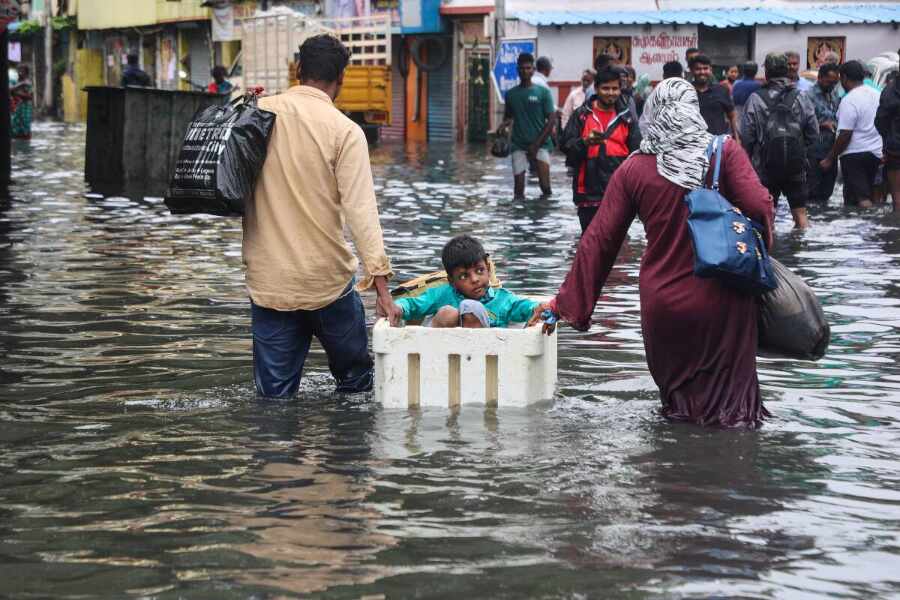An unfortunate inundation

Severe floods on account of heavy rainfall have once again come to haunt several districts of Tamil Nadu. The meteorological factors make October-November heavy rains a normal phenomenon but the intensity of the floods is indeed worrying. Tamil Nadu, along with other southern states, generally receives rainfall during two time periods — North-west monsoon (October-November period) and South-west monsoon (May-July period). The North-west monsoon is also called the primary monsoon and sets in around October 20 each year. The monsoon arrived a little late this year, and by that time, the state already had sufficient rainfall since the start of the year. A government release stated that since January Tamil Nadu has received 969.9 mm of rainfall — 37 per cent more than the normal of 706 mm. Water bodies and dams were already filled up to the brim and, as several districts received record one-day rainfall ranging from 11 cm to 23 cm, there was little that structures could hold, pushing the state under deluge. The situation got compounded as there was no accurate prediction of heavy rainfall for November 7-8. The affected districts were caught off guard. This once again raises serious questions around the credibility of weather forecasting departments, particularly during a peak period when such incidents are more likely to occur. Chennai is known to have been provided green alert (no warning, no action) till November 9, although heavy rains were predicted on November 10. Lack of real-time radars has propped up as a pertinent concern here. The coastal areas, particularly in the southern peninsula region, have become more vulnerable to climate crises in recent years. Sloppiness in procedural and technical efficiency is the last thing that should be allowed to creep in. Of course, the state CM has taken stock of the situation and the Central government has also reassured of all possible help. Food packets are being distributed among other things, but post-disaster relief is only an emergency provision and not part of the mitigation strategy. Certain parts of the state are expected to experience more of the heavy rains in coming days, meaning that temporary closure of schools, offices and other activities may be prolonged a bit further. While the emergency response of the government should be acknowledged, it is no substitute to better planning and technical efficiency. This argument particularly holds water as Tamil Nadu has been a witness to heavy rain-triggered devastating floods over the past several decades. Only six years back, it received 24 cm of rainfall in a single day in November. Before that, the state has been occasionally receiving such rainfall since the 1970s and 80s. The heavy rains have been resulting due to geographical conditions over the Bay of Bengal and Arabian sea. In the present case also, a low-pressure area over the Bay of Bengal is being attributed as the cause of heavy flooding. These factors are no doubt beyond the control of the governments. But what the governments could do is to upgrade the early warning and response strategy. Thanks to the efforts of NDRF, SDRF and other forces, the response to such a catastrophe has always been up to the mark. There is a need though to build upon the preparedness and early warning part. Every catastrophe is a lesson in itself, and each buffer time zone between two catastrophes is a grace period when the learnt things must be applied to bring positive and concrete solutions. There is a need to learn faster in today's scenario as the natural catastrophes are becoming more intensified in their scale and frequency. Presently, the intensity of rains and floods have already reached historic levels in Chennai. It should be hoped that the situation doesn't deteriorate much. The Central and state governments are expected to work in cohesion so as the people in Chennai face the least possible adversities and miseries. Apart from ensuring basic necessities of food, shelter and medicine, the government also faces the humongous task of restoring the halted services like transport, schools, hospitals etc. Partly the prayers, and partly the government's actions can help mitigate the current crisis in a steadfast manner. Perhaps, the state machinery should also show promptness in learning some lessons, so that next such disasters don't come as a complete shocker.



